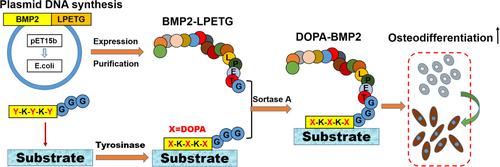当前位置:
X-MOL 学术
›
Biotechnol. Bioeng.
›
论文详情
Our official English website, www.x-mol.net, welcomes your
feedback! (Note: you will need to create a separate account there.)
Biointerface engineering through amalgamation of gene technology and site-specific growth factor conjugation for efficient osteodifferentiation
Biotechnology and Bioengineering ( IF 3.5 ) Pub Date : 2024-09-19 , DOI: 10.1002/bit.28852 Zhenxu Wu, Li Mo, Zongliang Wang, Liangsong Song, Eiry Kobatake, Yoshihiro Ito, Yi Wang, Peibiao Zhang
Biotechnology and Bioengineering ( IF 3.5 ) Pub Date : 2024-09-19 , DOI: 10.1002/bit.28852 Zhenxu Wu, Li Mo, Zongliang Wang, Liangsong Song, Eiry Kobatake, Yoshihiro Ito, Yi Wang, Peibiao Zhang

|
The development of bone implants through bioinspired immobilization of growth factors remains a key issue in the generation of biological interfaces, especially in enhancing osteodifferentiation ability. In this study, we developed a strategy for surface functionalization of poly(lactide-glycolide) (PLGA) and hydroxyapatite (HA) composite substrates through site-specific conjugation of bone morphogenetic protein 2 containing 3,4-hydroxyphenalyalanine (DOPA-BMP2) mediated by tyrosinase and sortase A (SrtA). Firstly, the growth factor BMP2-LPETG containing LPETG motif was successfully expressed in Escherichia coli through recombinant DNA technology. The excellent binding affinity of binding growth factor (DOPA-BMP2) was achieved by converting the tyrosine residue (Y) of YKYKY-GGG peptide into DOPA (X) by tyrosinase, which bound to the substrates. Then its GGG motif was specifically bound to the end of BMP2-LPETG mediated by SrtA. Therefore, the generated bioactive DOPA-BMP2/PLGA/HA substrates significantly promoted the osteogenic differentiation of MC3T3-E1 cells. Thanks to this microbial-assisted engineering approach, our work presents a facile and highly site-specific strategy to engineer biomimetic materials for orthopedics and dentistry by effectively delivering growth factors, peptides, and other biomacromolecules.
中文翻译:

通过基因技术和位点特异性生长因子偶联的融合进行生物界面工程,以实现高效的成骨分化
通过生长因子的生物启发固定化开发骨植入物仍然是生物界面产生的关键问题,尤其是在增强成骨分化能力方面。在这项研究中,我们开发了一种通过酪氨酸酶和分选酶 A 介导的含有 3,4-羟基苯丙氨酸 (DOPA-BMP2) 的骨形态发生蛋白 2 的位点特异性共轭,开发出一种聚丙交酯-乙交酯 (PLGA) 和羟基磷灰石 (HA) 复合底物表面功能化的策略。首先,通过重组 DNA 技术在大肠杆菌中成功表达含有 LPETG 基序的生长因子 BMP2-LPETG。结合生长因子 (DOPA-BMP2) 的优异结合亲和力是通过酪氨酸酶将 YKYKY-GGG 肽的酪氨酸残基 (Y) 转化为 DOPA (X) 来实现的,酪氨酸酶与底物结合。然后其 GGG 基序特异性结合到 SrtA 介导的 BMP2-LPETG 末端。因此,产生的生物活性 DOPA-BMP2/PLGA/HA 底物显着促进了 MC3T3-E1 细胞的成骨分化。由于这种微生物辅助工程方法,我们的工作提出了一种简单且高度针对特定位置的策略,通过有效递送生长因子、肽和其他生物大分子来设计骨科和牙科的仿生材料。
更新日期:2024-09-19
中文翻译:

通过基因技术和位点特异性生长因子偶联的融合进行生物界面工程,以实现高效的成骨分化
通过生长因子的生物启发固定化开发骨植入物仍然是生物界面产生的关键问题,尤其是在增强成骨分化能力方面。在这项研究中,我们开发了一种通过酪氨酸酶和分选酶 A 介导的含有 3,4-羟基苯丙氨酸 (DOPA-BMP2) 的骨形态发生蛋白 2 的位点特异性共轭,开发出一种聚丙交酯-乙交酯 (PLGA) 和羟基磷灰石 (HA) 复合底物表面功能化的策略。首先,通过重组 DNA 技术在大肠杆菌中成功表达含有 LPETG 基序的生长因子 BMP2-LPETG。结合生长因子 (DOPA-BMP2) 的优异结合亲和力是通过酪氨酸酶将 YKYKY-GGG 肽的酪氨酸残基 (Y) 转化为 DOPA (X) 来实现的,酪氨酸酶与底物结合。然后其 GGG 基序特异性结合到 SrtA 介导的 BMP2-LPETG 末端。因此,产生的生物活性 DOPA-BMP2/PLGA/HA 底物显着促进了 MC3T3-E1 细胞的成骨分化。由于这种微生物辅助工程方法,我们的工作提出了一种简单且高度针对特定位置的策略,通过有效递送生长因子、肽和其他生物大分子来设计骨科和牙科的仿生材料。































 京公网安备 11010802027423号
京公网安备 11010802027423号